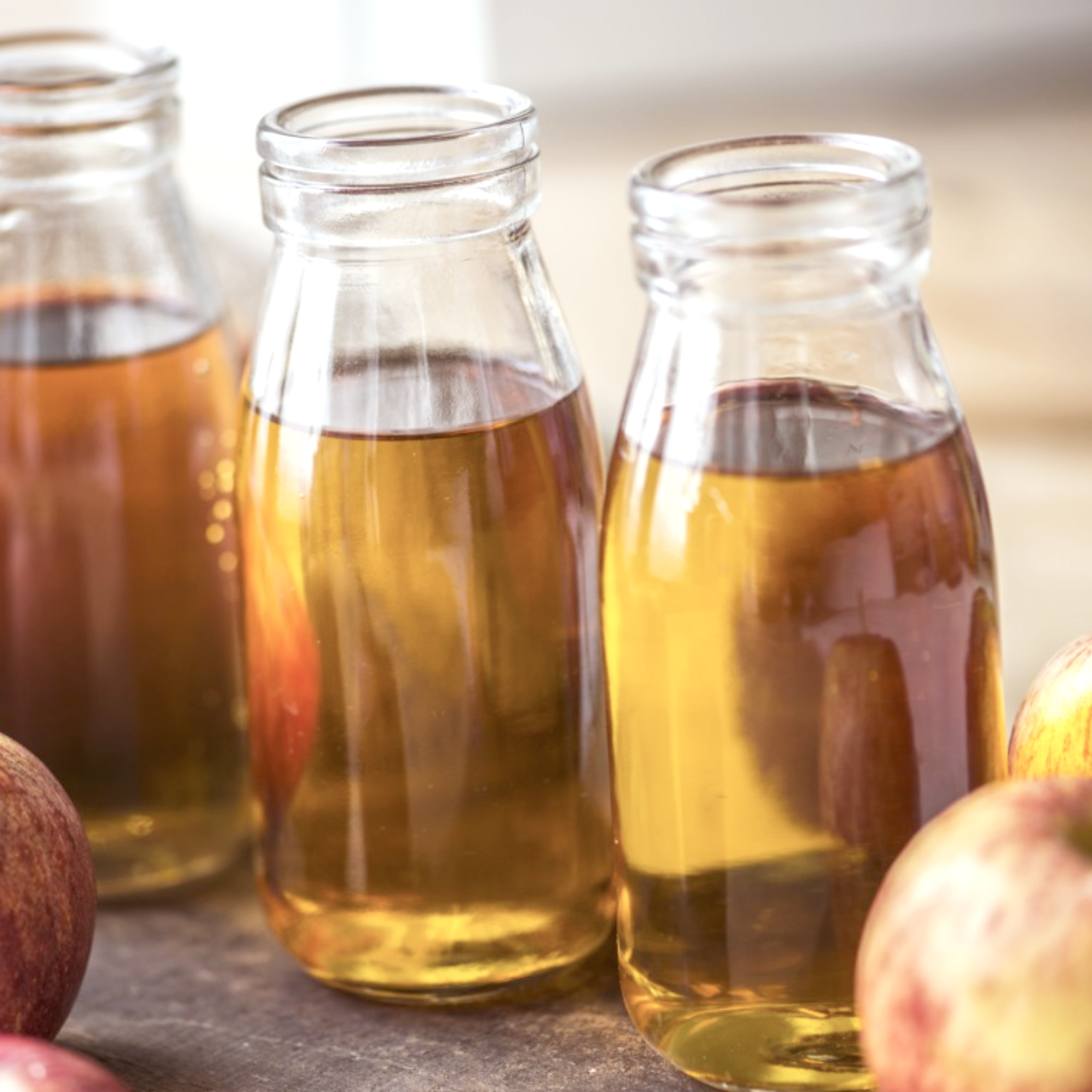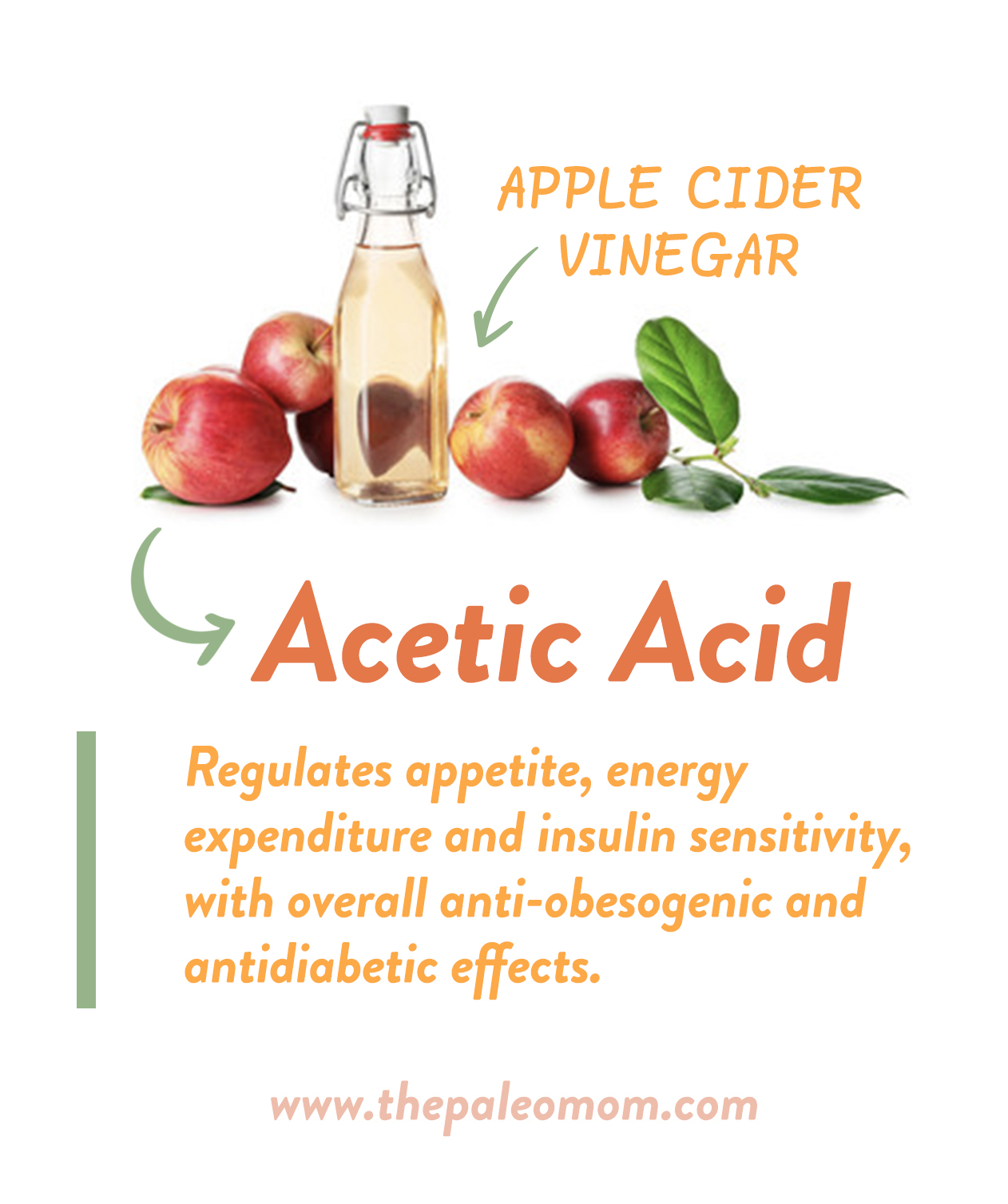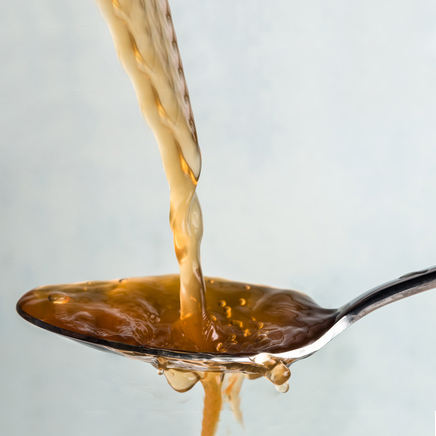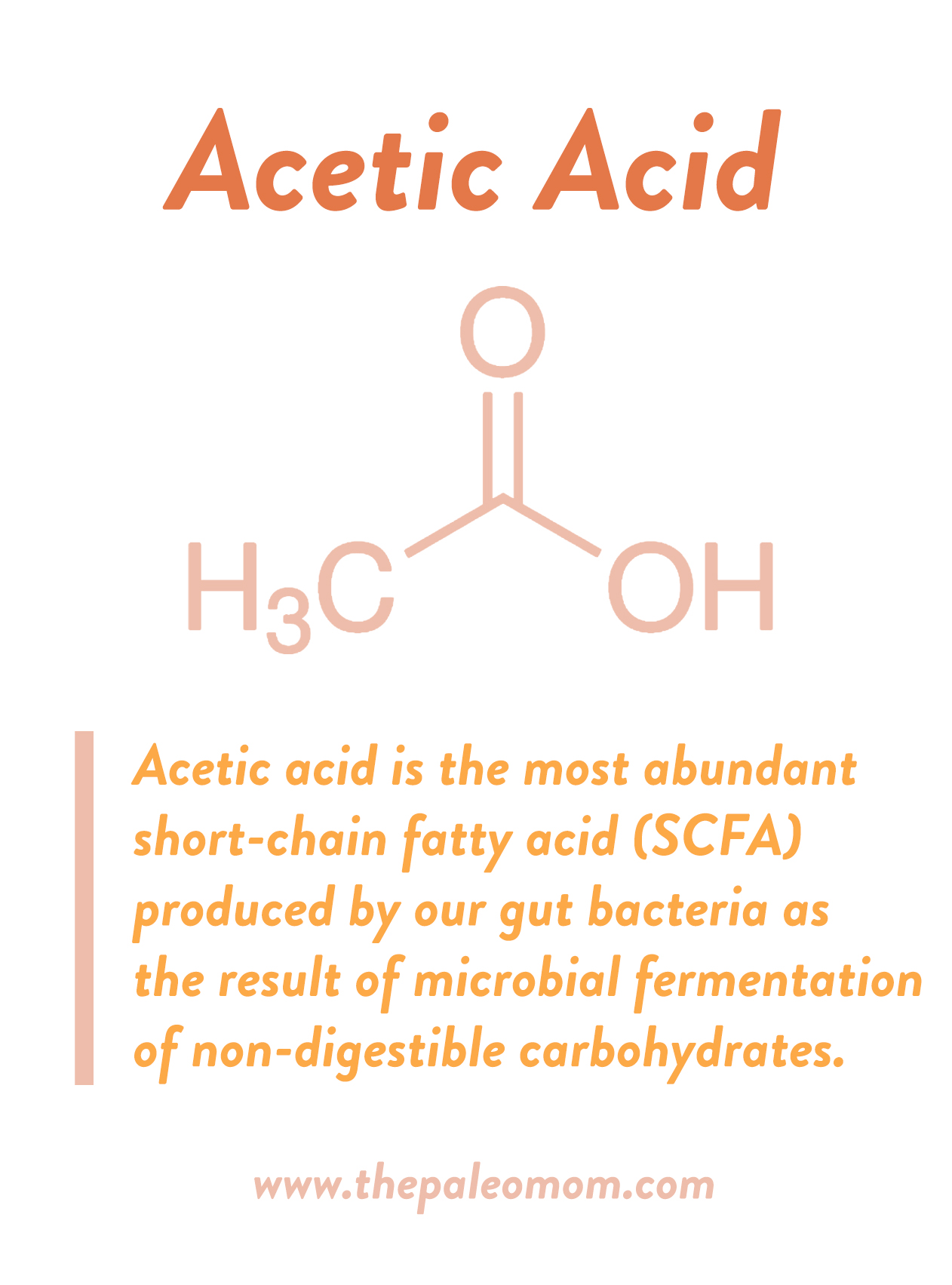 When we think about the benefits of consuming fermented foods, we tend to focus on fermented vegetables (like sauerkraut, kimchee, and pickles), kombucha and kefir (see The Health Benefits of Fermented Foods). But, apple cider vinegar also deserves a spot on the fermented food pedestal of fame.
When we think about the benefits of consuming fermented foods, we tend to focus on fermented vegetables (like sauerkraut, kimchee, and pickles), kombucha and kefir (see The Health Benefits of Fermented Foods). But, apple cider vinegar also deserves a spot on the fermented food pedestal of fame.
Apple cider vinegar, or ACV, is made in a 2-step process. First, apples are crushed to make fresh apple cider. Yeast, and sometimes sugar, is added for a first fermentation, converting the naturally-occurring and added sugars in the apple cider into alcohol. Second, a vinegar “mother” (very similar to a kombucha scoby) is added, which mainly contains Acetobacter bacteria that convert the alcohol into acetic acid (wild Acetobacter fermentation is also possible). The beneficial compounds in ACV include those that originate from the apples themselves (apples are a rich source of polyphenols) as well as the metabolic byproducts of both fermentations.
Beneficial Compounds in ACV
While ACV is no powerhouse of nutrition when it comes to vitamin and mineral content, there are a number of beneficial compounds in apple cider vinegar that make it stand out as a functional food.
 Many researchers attribute the health benefits of apple cider vinegar exclusively to its acetic acid content, which varies between about 4% and 10%; its concentration is actually the measure of the strength of vinegar. Acetic acid (or more specifically, the anion of its salt, acetate ion) is the dominant short-chain fatty acid in human blood, estimated at 50-60 μmol/L. Acetate regulates appetite, energy expenditure and insulin sensitivity, with overall anti-obesogenic and antidiabetic effects.
Many researchers attribute the health benefits of apple cider vinegar exclusively to its acetic acid content, which varies between about 4% and 10%; its concentration is actually the measure of the strength of vinegar. Acetic acid (or more specifically, the anion of its salt, acetate ion) is the dominant short-chain fatty acid in human blood, estimated at 50-60 μmol/L. Acetate regulates appetite, energy expenditure and insulin sensitivity, with overall anti-obesogenic and antidiabetic effects.
Within the cell, acetate is converted into acetyl-CoA (catalyzed by acetyl-CoA synthetases), which delivers its acetyl group to the citric acid cycle (aka the Krebs cycle, see How Does Sugar Fit into a Healthy Diet?) for the production of adenosine triphosphate (ATP), the energy currency for all cells. Because acetate improves substrate utilization, it increases fasting fat oxidation and energy expenditure. Acetate also increases lipolysis in adipocytes, implying improved usage of stored energy. Furthermore, acetate may support “browning” of adipose tissue, the conversion of white adipose tissue to the beneficial brown adipose tissue, or BAT, which is thermogenic and so increases basal metabolic rate (see also 10 Nutrients that Can Help You Burn Fat). And, thanks to its effects on adipose tissue, acetate also has anti-inflammatory effects, reducing the levels of pro-inflammatory cytokines in the blood.
Acetate regulates the secretion of gut-derived hunger hormones like glucagon-like peptide-1, peptide YY and ghrelin, thereby reducing appetite, but also has a direct effect on satiety signaling in the brain via GABA production and decreased neuropeptide Y (see also The Hormones of Hunger). Acetate improves insulin sensitivity and blood glucose regulation through its impact on metabolism and appetite but also directly via binding to G-protein coupled receptors, including several already implicated in the development of insulin resistance and pancreatic β-cell dysfunction. While we do make some of our own acetate, our dominant sources are diet and production by our gut bacteria. In fact, we use about 45 grams of acetate per day!
ACV also contains small amount of other beneficial organic acids produced as metabolic byproducts during fermentation, including malic acid, lactic acid, and citric acid.
lactic acid. In addition to regulating energy metabolism (by impacting the rate of both glycolysis and lipolysis), lactic acid is an important metabolic intermediary in the gut microbiome, supporting the growth of key beneficial bacteria. Studies also show that lactic acid has important roles in maintaining the gut barrier as well as modulating immune function.
malic acid. Malic acid is another intermediary in the citric acid cycle, supporting metabolism. It’s also been shown to improve mood, blood sugar regulation, and exercise performance, and reduce chronic pain, especially in the context of fibromyalgia.
citric acid. In addition to its obvious role in the citric acid cycle thereby supporting metabolism, citric acid has antioxidant and anti-inflammatory properties. Citric acid also protects the liver from damage and reduces lipid peroxidation.
ACV is also rich in phenolic compounds and flavonoids, originating from the apple cider itself and transformed into a greater variety of phenolics and flavonoids during fermentation (see also The Amazing World of Plant Phytochemicals: Why a diet rich in veggies is so important! and Polyphenols: Magic Bullet or Health Hype?. In particular, ACV is a great source of gallic acid, catechin, chlorogenic acid, p-hydroxybenzoic acid, syringic acid, caffeic acid and p-coumaric acid. Each one of these phytochemicals is associated with health benefits:
gallic acid. Studies show that gallic acid has potent antioxidant effects, reduces inflammation, and may protect against cardiovascular disease, cancer, and infection. In fact, gallic acid may prove useful in the treatment of depression, cancer, and some types of infection.
Nutrivore Weekly Serving Matrix
An easy-to-use and flexible weekly checklist
to help you maximize nutrient-density.
The Weekly Serving Matrix is very helpful! I’ve been eating along these lines but this really helps me know where to focus vs. which foods serve a more secondary role. It’s super helpful and has taken a lot of worry out of my meal planning. Thanks!
Jan
caffeic acid. Studies suggest caffeic acid can reduce inflammation, prevent cancer, prevent toxicity associated with chemotherapy and radiation, prevent diabetes, prevent premature aging, prevent neurodegenerative diseases (like Parkinson’s disease), and reduce exercise-related fatigue.
p-coumaric acid. Studies suggest p-coumaric acid can reduce inflammation, reduce intestinal inflammation, regulate the immune system, improve bone density, act as an antidepressant, prevent cancer, protect against kidney damage, and protect against tissue damage caused by drugs and alcohol.
syringic acid. Studies show that syringic acid may protect against cancer, diabetes, liver damage and lung damage.
catechin. Studies show that catechins act as antioxidants but also boost the activity of antioxidant enzymes. Catechins are also anti-inflammatory and modulate the immune system, anti-bacterial, anti-cancer and can boost metabolism and promote healthy weight loss.
p-hydroxybenzoic acid. Studies show that p-hydroxybenzoic acid is a potent antioxidant with weak estrogenic properties. Animal studies have shown that it has a hypoglycemic effect (lowering blood sugar) that is mediated via increased peripheral glucose consumption (rather than directly impacting insulin).
chlorogenic acid. Studies suggest chlorogenic acid can reduce blood sugar, prevent diabetes, aid in weight loss, reduce blood pressure, aid in homocysteine detoxification, and enhance mood.
Apple cider vinegar rivals other superfoods for its antioxidant capacity. One study measured its Trolox equivalent antioxidant capacity (TEAC) at 12.56 mM/g. For comparison, that’s about the same as a super high quality black tea and about 32X higher than dark chocolate—not too shabby!
Finally, raw apple cider vinegar contains really important live probiotic bacteria and yeast! A study of organic and conventional apple cider vinegar identified the bacteria Acetobacter pasteurianus, Acetobacter ghanensis, Komagataeibacter oboediens, and Komagataeibacter saccharivorans in the organic apple cider vinegar and Acetobacter pasteurianus and Komagataeibacter oboediens in the conventional apple cider vinegar. Likewise, the acid-resistant beneficial yeasts Candida ethanolica, Pichia membranifaciens, and Saccharomycodes ludwigii were also isolated from the vinegar. This makes a strong argument for raw, organic apple cider vinegar!
Health Benefits of ACV Supplementation
While large-scale randomized control trials are still needed to quantify the benefits of ACV supplementation in different populations, there’s emerging evidence that a daily dose of apple cider vinegar can be a boon to our metabolic health, as you would expect from our above examination of the beneficial compounds in ACV.
Diabetes and Insulin Resistance

Various rodent studies have shown that apple cider vinegar supplementation improves glucose regulation in diabetic animals, in addition to increasing antioxidant status, including increasing superoxide dismutase, glutathione peroxidase, vitamin C, vitamin E, and β-carotene.
In a 2004 cross-over study, insulin sensitive, insulin resistant and type 2 diabetic participants consumed 20 grams of apple cider vinegar (or placebo) followed 2 minutes later by a meal of a white bagel, butter, and orange juice. The strongest effect was in the insulin resistant participants who had significantly decreased postprandial serum glucose and insulin levels, while type 2 diabetics saw only a slight improvement.
In a 2015 cross-over study of 11 newly-diagnosed type 2 diabetics, participants consumed 30mL of vinegar (or a placebo) followed 5 minutes later by a breakfast composed of bread, cheese, turkey ham, orange juice, butter, and a cereal bar. Drinking the vinegar prior to eating resulted in significantly lower postprandial serum glucose and insulin, attributable to increased glucose uptake into skeletal muscle.
A 2019 study of 70 diabetics with hyperlipidemia on lipid-lowering drugs showed that 20 mL of apple cider vinegar daily for 8 weeks resulted in significantly lower fasting blood sugar (dropping an average of 10 mg/dL compared to the control group’s increase of 16 mg/dL).
Obesity
 Various rodent studies have shown that apple cider vinegar supplementation has an anti-obesogenic effect, mediated in large part via reduced food intake. When rats are fed a high-fat diet but supplemented with ACV, they tend to eat much less than the high-fat diet controls, thereby avoiding the weight gain, worsening lipid profile, and insulin resistance normally caused by the high-fat diet. However, the benefits to weight management aren’t simply attributable to appetite suppression. A mouse study showed that even without a change in food intake, acetic acid supplementation protected mice from obesity thanks to an epigenetic effect, upregulating genes for fatty-acid-oxidation-related and thermogenesis-related proteins, implying a direct metabolic benefit.
Various rodent studies have shown that apple cider vinegar supplementation has an anti-obesogenic effect, mediated in large part via reduced food intake. When rats are fed a high-fat diet but supplemented with ACV, they tend to eat much less than the high-fat diet controls, thereby avoiding the weight gain, worsening lipid profile, and insulin resistance normally caused by the high-fat diet. However, the benefits to weight management aren’t simply attributable to appetite suppression. A mouse study showed that even without a change in food intake, acetic acid supplementation protected mice from obesity thanks to an epigenetic effect, upregulating genes for fatty-acid-oxidation-related and thermogenesis-related proteins, implying a direct metabolic benefit.
A 2009 randomized trial in obese Japanese people (BMI between 25 and 30) evaluated the weight loss benefits 2 tablespoons of apple cider vinegar daily versus 1 tablespoon versus placebo (the vinegar was “hidden” in a 500mL beverage, half consumed after breakfast and half consumed after dinner). The participants made no changes to diet or activity levels during the 12-week treatment period. Despite no change in diet or activity, the 1-tablespoon group lost an average of 1.2 kg and 0.7% body fat and the 2-tablespoon group lost an average of 1.9 kg and 0.9% body fat. The vinegar groups lost a significant amount of both subcutaneous and visceral fat. Daily vinegar also lowered serum triglycerides, by 18% in the 1-tablespoon group and 26% in the 2-tablespoon group.
A 2018 randomized trial evaluated whether 2 tablespoons of apple cider vinegar daily (15mL with lunch and 15mL with dinner) could improve the effects of a 250-calorie energy deficit weight-loss diet in 39 obese people (average BMI was 32). After 12 weeks, the ACV group had lost more weight (4 kg average weight lost compared to the control group’s 2.4 kg) and more fat mass (2.3 kg average fat lost compared to the control group’s 1.1 kg). The ACV group also had a concurrent drop in triglycerides (an impressive 58 mg/dL average decrease compared to the control group’s 45 mg/dL increase) and increase in HDL (good) cholesterol (3.0 mg/dL increase compared to the control group’s 0.7 mg/dL increase). The ACV group also experienced better appetite reduction compared to the control group.
Acetic Acid and the Gut Microbiome
Many of the benefits of apple cider vinegar may be mediated through the microbiome (see also What Is the Gut Microbiome? And Why Should We Care About It?).
 Acetic acid is the most abundant short-chain fatty acid (SCFA) produced by our gut bacteria as the result of microbial fermentation of non-digestible carbohydrates (predominantly fiber, especially soluble, and resistant starch) as well as proteins. In fact, between 3 and 10 times more acetic acid is produced than the other two main SCFAs, propionic acid and butyric acid (and these three SCFAs collectively represent up to 95% of the SCFAs produced in the colon). Along with its effects on human tissue, acetic acid is extremely important for various members of the gut microbiome, via cross-feeding.
Acetic acid is the most abundant short-chain fatty acid (SCFA) produced by our gut bacteria as the result of microbial fermentation of non-digestible carbohydrates (predominantly fiber, especially soluble, and resistant starch) as well as proteins. In fact, between 3 and 10 times more acetic acid is produced than the other two main SCFAs, propionic acid and butyric acid (and these three SCFAs collectively represent up to 95% of the SCFAs produced in the colon). Along with its effects on human tissue, acetic acid is extremely important for various members of the gut microbiome, via cross-feeding.
Cross-feeding refers to the fact that some microbial species in the gut, instead of directly fermenting undigested food compounds, ferment the products produced by carbohydrate fermentation by other bacterial species. Yes, some bacteria’s favorite food is other bacteria’s poop. And while acetic acid directly impacts our health, it also provides fermentable substrate for some very desirable strains of bacteria. For example, it has been shown that consuming fructan fiber increases the production of butyrate (the salt of butyric acid), but the two main types of bacteria that ferment fructans—Bifidobacteria and Lactobacilli—are lactic acid-producing bacteria, i.e., the major products of their fermentation are lactic and acetic acid, not butyric acid. The explanation for this bump in butyrate production is that many other bacteria—including Eubacterium, Roseburia, and Faecalibacterium—ferment lactic and acetic acid to produce butyric acid. Acetic acid also serves as an essential co-factor and metabolite for key bacteria like Faecalibacterium prausnitzii, which requires acetic acid to grow. Through this cross-feeding, acetic acid-producing bacteria (and dietary acetic acid) help maintain the health of the overall microbiome by supporting populations of other beneficial microbes.
In fact, a 2017 mouse study showed that either high-fiber feeding or acetate supplementation had similar benefits to gut dysbiosis, normalizing the Bacteroidetes to Firmicutes ratio, showing that acetate production is a major mechanism behind benefits of a high-fiber diet. In fact, the same study showed that both high-fiber diet and acetate supplementation performed equally well for improving blood pressure in a cardiovascular disease model. This doesn’t mean we can give up veggies as long as we’re chugging some ACV, but it does imply that we can improve our gut microbiome composition by adding ACV to an already microbiome-friendly diet! (See also How Many Carbs Should We Eat?, What Is the Gut Microbiome? And Why Should We Care About It?, Paleo, Resistant Starch, and TMAO: New Study Warning Worth Heeding, Why Root Veggies Are Great for the Gut Microbiome, Why Fish is Great for the Gut Microbiome, The Importance of Vegetables and Why Fruit is a Good Source of Carbohydrates).
How to Take ACV
 One way to benefit from ACV is to embrace the vinaigrette, dressing salad or vegetables at least twice a day. As a general rule, combine 1/3 cup apple cider vinegar with 1/2 cup high-quality olive or avocado oil; keep it simple with a little salt and pepper or add your favorite chopped herbs. Voila!
One way to benefit from ACV is to embrace the vinaigrette, dressing salad or vegetables at least twice a day. As a general rule, combine 1/3 cup apple cider vinegar with 1/2 cup high-quality olive or avocado oil; keep it simple with a little salt and pepper or add your favorite chopped herbs. Voila!
If you’re considering ACV supplementation, the most common way to take ACV is diluted in water, and chugged quickly just prior to a meal (anywhere between 5 minutes and 30 minutes). However, it’s worth noting that there’s some evidence that drinking ACV daily can cause tooth erosion (although more research on this is certainly warranted and it’s unclear if this only occurs with undiluted vinegar) and ACV tablets that have long been marketed as an alternative have been shown to sometimes cause esophageal injury. Plus, most people do not like the taste, me among them! Drum roll, please….
That’s why I’ve fallen in love with Paleovalley Apple Cider Vinegar Complex, which encapsulates ACV goodness with four additional superfoods: turmeric, ginger, Ceylon cinnamon and lemon, each packed with extensively studied beneficial phytochemicals! Each easy-to-swallow capsule (no getting stuck and damaging the esophagus like tablets) contains 1000 mg of air-dried (room temperature, not under heat) apple cider vinegar (the equivalent of about 1.5 tablespoons!!!) plus 300 mg turmeric, 300 mg ginger, 150 mg Ceylon cinnamon and 50 mg freeze-dried lemon. It’s my preferred way to get my daily ACV!
Check Out Paleovalley ACV Complex
Citations
Akbulut MB, Guneser MB, Eldeniz AU. Effects of fruit vinegars on root dentin microhardness and roughness. J Conserv Dent. 2019 Jan-Feb;22(1):97-101. doi: 10.4103/JCD.JCD_394_18.
Bakir S, Toydemir G, Boyacioglu D, Beekwilder J, Capanoglu E. Fruit Antioxidants during Vinegar Processing: Changes in Content and in Vitro Bio-Accessibility. Int J Mol Sci. 2016 Sep 29;17(10):1658. doi: 10.3390/ijms17101658.
Bouderbala H, Kaddouri H, Kheroua O, Saidi D. Anti-obesogenic effect of apple cider vinegar in rats subjected to a high fat diet. Ann Cardiol Angeiol (Paris). 2016 Jun;65(3):208-13. doi: 10.1016/j.ancard.2016.04.004.
Budak NH, Aykin E, Seydim AC, Greene AK, Guzel-Seydim ZB. Functional properties of vinegar. J Food Sci. 2014 May;79(5):R757-64. doi: 10.1111/1750-3841.12434.
Budak NH, Kumbul Doguc D, Savas CM, Seydim AC, Kok Tas T, Ciris MI, Guzel-Seydim ZB. Effects of apple cider vinegars produced with different techniques on blood lipids in high-cholesterol-fed rats. J Agric Food Chem. 2011 Jun 22;59(12):6638-44. doi: 10.1021/jf104912h.
den Besten G, van Eunen K, Groen AK, Venema K, Reijngoud DJ, Bakker BM.The role of short-chain fatty acids in the interplay between diet, gut microbiota, and host energy metabolism. Journal of Lipid Research. 2013 Sep;54(9):2325-40. doi: 10.1194/jlr.R036012.
Fu Q, Shi Q, West TM, Xiang YK. Cross-Talk Between Insulin Signaling and G Protein-Coupled Receptors. J Cardiovasc Pharmacol. 2017 Aug;70(2):74-86. doi: 10.1097/FJC.0000000000000481.
Fushimi T, Suruga K, Oshima Y, Fukiharu M, Tsukamoto Y, Goda T. Dietary acetic acid reduces serum cholesterol and triacylglycerols in rats fed a cholesterol-rich diet. Br J Nutr. 2006 May;95(5):916-24. doi: 10.1079/bjn20061740.
Gheflati A, Bashiri R, Ghadiri-Anari A, Reza JZ, Kord MT, Nadjarzadeh A. The effect of apple vinegar consumption on glycemic indices, blood pressure, oxidative stress, and homocysteine in patients with type 2 diabetes and dyslipidemia: A randomized controlled clinical trial. Clin Nutr ESPEN. 2019 Oct;33:132-138. doi: 10.1016/j.clnesp.2019.06.006.
Gopal J, Anthonydhason V, Muthu M, Gansukh E, Jung S, Chul S, Iyyakkannu S. Authenticating apple cider vinegar’s home remedy claims: antibacterial, antifungal, antiviral properties and cytotoxicity aspect. Nat Prod Res. 2019 Mar;33(6):906-910. doi: 10.1080/14786419.2017.1413567.
Halima BH, Sonia G, Sarra K, Houda BJ, Fethi BS, Abdallah A. Apple Cider Vinegar Attenuates Oxidative Stress and Reduces the Risk of Obesity in High-Fat-Fed Male Wistar Rats. J Med Food. 2018 Jan;21(1):70-80. doi: 10.1089/jmf.2017.0039.
Hernández MAG, Canfora EE, Jocken JWE, Blaak EE. The Short-Chain Fatty Acid Acetate in Body Weight Control and Insulin Sensitivity. Nutrients. 2019 Aug 18;11(8):1943. doi: 10.3390/nu11081943.
Hill LL, Woodruff LH, Foote JC, Barreto-Alcoba M. Esophageal injury by apple cider vinegar tablets and subsequent evaluation of products. J Am Diet Assoc. 2005 Jul;105(7):1141-4. doi: 10.1016/j.jada.2005.04.003.
Hmad Halima B, Sarra K, Jemaa Houda B, Sonia G, Abdallah A. Antidiabetic and Antioxidant Effects of Apple Cider Vinegar on Normal and Streptozotocin-Induced Diabetic Rats. Int J Vitam Nutr Res. 2018 Dec;88(5-6):223-233. doi: 10.1024/0300-9831/a000246.
Ho CW, Lazim AM, Fazry S, Zaki UKHH, Lim SJ. Varieties, production, composition and health benefits of vinegars: A review. Food Chem. 2017;221:1621‐1630. doi:10.1016/j.foodchem.2016.10.128
Khezri SS, Saidpour A, Hosseinzadeh N, Amiri Z. Beneficial effects of Apple Cider Vinegar on weight management, Visceral Adiposity Index and lipid profile in overweight or obese subjects receiving restricted calorie diet: A randomized clinical trial. J Functional Foods. 2018 43:95-102. doi: 10.1016/j.jff.2018.02.003.
Kondo T, Kishi M, Fushimi T, Kaga T. Acetic acid upregulates the expression of genes for fatty acid oxidation enzymes in liver to suppress body fat accumulation. J Agric Food Chem. 2009 Jul 8;57(13):5982-6. doi: 10.1021/jf900470c.
Kondo T, Kishi M, Fushimi T, Ugajin S, Kaga T. Vinegar intake reduces body weight, body fat mass, and serum triglyceride levels in obese Japanese subjects. Biosci Biotechnol Biochem. 2009 Aug;73(8):1837-43. doi: 10.1271/bbb.90231.
Laličić-Petronijević J, Komes D, Gorjanović S, Belščak-Cvitanović A, Pezo L, Pastor F, Ostojić S, Popov-Raljić J, Sužnjević D. Content of Total Phenolics, Flavan-3-Ols and Proanthocyanidins, Oxidative Stability and Antioxidant Capacity of Chocolate During Storage. Food Technol Biotechnol. 2016 Mar;54(1):13-20. doi: 10.17113/ftb.54.01.16.4014.
Lim J, Henry CJ, Haldar S. Vinegar as a functional ingredient to improve postprandial glycemic control-human intervention findings and molecular mechanisms. Mol Nutr Food Res. 2016 Aug;60(8):1837-49. doi: 10.1002/mnfr.201600121.
Luo D, Xu X. EBioMedicine. Vinegar could act by gut microbiome. 2019 Aug;46:30. doi: 10.1016/j.ebiom.2019.07.061.
Marques FZ, Nelson E, Chu PY, Horlock D, Fiedler A, Ziemann M, Tan JK, Kuruppu S, Rajapakse NW, El-Osta A, Mackay CR, Kaye DM. High-Fiber Diet and Acetate Supplementation Change the Gut Microbiota and Prevent the Development of Hypertension and Heart Failure in Hypertensive Mice. Circulation. 2017 Mar 7;135(10):964-977. doi: 10.1161/CIRCULATIONAHA.116.024545.
Mitrou P, Petsiou E, Papakonstantinou E, Maratou E, Lambadiari V, Dimitriadis P, Spanoudi F, Raptis SA, Dimitriadis G. Vinegar Consumption Increases Insulin-Stimulated Glucose Uptake by the Forearm Muscle in Humans with Type 2 Diabetes. J Diabetes Res. 2015;2015:175204. doi: 10.1155/2015/175204.
Morrison DJ, Preston T. Formation of short chain fatty acids by the gut microbiota and their impact on human metabolism. Gut Microbes. 2016 May 3;7(3):189-200. doi: 10.1080/19490976.2015.1134082.
Nazıroğlu M, Güler M, Özgül C, Saydam G, Küçükayaz M, Sözbir E. Apple cider vinegar modulates serum lipid profile, erythrocyte, kidney, and liver membrane oxidative stress in ovariectomized mice fed high cholesterol. J Membr Biol. 2014 Aug;247(8):667-73. doi: 10.1007/s00232-014-9685-5.
Panetta C. J., Jonk Y. C., Shapiro A. C. Prospective randomized clinical trial evaluating the impact of vinegar on lipids in non-diabetics. World Journal of Cardiovascular Diseases. 2013;03(02):191–196. doi: 10.4236/wjcd.2013.32027.
Shishehbor F, Mansoori A, Sarkaki AR, Jalali MT, Latifi SM. Apple cider vinegar attenuates lipid profile in normal and diabetic rats. Pak J Biol Sci. 2008 Dec 1;11(23):2634-8. doi: 10.3923/pjbs.2008.2634.2638.
Štornik A, Skok B, Trček J. Comparison of Cultivable Acetic Acid Bacterial Microbiota in Organic and Conventional Apple Cider Vinegar. Food Technol Biotechnol. 2016 Mar;54(1):113-119. doi: 10.17113/ftb.54.01.16.4082.
Sun Y, O’Riordan MX. Regulation of bacterial pathogenesis by intestinal short-chain fatty acids. Advances in Applied Microbiology. 2013. 85:93‐118. doi:10.1016/B978-0-12-407672-3.00003-4.
Trček J, Mahnič A, Rupnik M. Diversity of the microbiota involved in wine and organic apple cider submerged vinegar production as revealed by DHPLC analysis and next-generation sequencing. Int J Food Microbiol. 2016 Apr 16;223:57-62. doi: 10.1016/j.ijfoodmicro.2016.02.007.
Yagnik D, Serafin V, J Shah A. Antimicrobial activity of apple cider vinegar against Escherichia coli, Staphylococcus aureus and Candida albicans; downregulating cytokine and microbial protein expression. Sci Rep. 2018 Jan 29;8(1):1732. doi: 10.1038/s41598-017-18618-x.
Yetiman AE, Kesmen Z. Identification of acetic acid bacteria in traditionally produced vinegar and mother of vinegar by using different molecular techniques. Int J Food Microbiol. 2015 Jul 2;204:9-16. doi: 10.1016/j.ijfoodmicro.2015.03.013.











